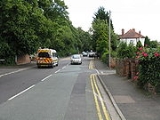
Red Hill, Worcester
Encyclopedia

Worcester
The City of Worcester, commonly known as Worcester, , is a city and county town of Worcestershire in the West Midlands of England. Worcester is situated some southwest of Birmingham and north of Gloucester, and has an approximate population of 94,000 people. The River Severn runs through the...
, Worcestershire
Worcestershire
Worcestershire is a non-metropolitan county, established in antiquity, located in the West Midlands region of England. For Eurostat purposes it is a NUTS 3 region and is one of three counties that comprise the "Herefordshire, Worcestershire and Warwickshire" NUTS 2 region...
, England
England
England is a country that is part of the United Kingdom. It shares land borders with Scotland to the north and Wales to the west; the Irish Sea is to the north west, the Celtic Sea to the south west, with the North Sea to the east and the English Channel to the south separating it from continental...
. It is in the south-east of the city on the A44
A44 road
The A44 is a major road in the United Kingdom that runs from Oxford in southern England to Aberystwyth in west Wales.-History:The original route of the A44 was Chipping Norton to Aberystwyth. No changes were made to the route of the A44 in the early years...
. It has historically been used as high ground to attack the city and as a place of execution.
History
Red Hill is mentioned regarding King StephenStephen of England
Stephen , often referred to as Stephen of Blois , was a grandson of William the Conqueror. He was King of England from 1135 to his death, and also the Count of Boulogne by right of his wife. Stephen's reign was marked by the Anarchy, a civil war with his cousin and rival, the Empress Matilda...
's attack upon the city of Worcester in 1149. He burnt Worcester and expelled William de Beauchamp
William de Beauchamp
William de Beauchamp may refer to:*William de Beauchamp , , Anglo-Norman baron and sheriff*William de Beauchamp , English judge and High Sheriff*William de Beauchamp , Anglo-Norman baron and sheriff...
, but the castle against which he raised two forts at Red Hill near Digly and Henwicks Hill resisted his attacks. It was said that the remains of this fort could still be seen in 1820.
In the 17th century, it was an area of execution. Edward Oldcorne
Edward Oldcorne
Blessed Edward Oldcorne or Oldcorn alias Hall was an English Jesuit priest. He was known to people who knew of the Gunpowder Plot to destroy the Parliament of England and kill King James I, and, although his involvement is unclear, he was caught up in the subsequent investigation...
and Ralph Ashley
Ralph Ashley
Blessed Ralph Ashley was an English Jesuit lay-brother who became involved with the aftermath of the Gunpowder Plot. He is a Catholic martyr, beatified in 1929.-Life:...
who had been captured at nearby Hindlip Hall
Hindlip Hall
Hindlip Hall is in Worcestershire. The first major hall was built before 1575. It played a significant role in both the Babington and the Gunpowder plots . It was Humphrey Littleton who told the authorities that Edward Oldcorne was hiding here after he had been heard saying Mass at Hindlip Hall...
were hanged, drawn and quartered
Hanged, drawn and quartered
To be hanged, drawn and quartered was from 1351 a penalty in England for men convicted of high treason, although the ritual was first recorded during the reigns of King Henry III and his successor, Edward I...
on the 7 April 1606. Holy relic
Relic
In religion, a relic is a part of the body of a saint or a venerated person, or else another type of ancient religious object, carefully preserved for purposes of veneration or as a tangible memorial...
s of these Jesuit priests are still reverred today. The others executed were a tenant farmer named Perkes, Humphrey Littleton
Humphrey Littleton (plotter)
Humphrey Littleton died on 7 April 1606 at Red Hill outside Worcester. He was executed for his involvement in the Gunpowder plot. Robert Wintour and Stephen Littleton who had escaped from the fight at Holbeche House were captured at Hagley Park on the 9 January 1606 despite Littleton's protests...
and John Wintour. All were executed for involvement with the Gunpowder plot
Gunpowder Plot
The Gunpowder Plot of 1605, in earlier centuries often called the Gunpowder Treason Plot or the Jesuit Treason, was a failed assassination attempt against King James I of England and VI of Scotland by a group of provincial English Catholics led by Robert Catesby.The plan was to blow up the House of...
.
The hill featured also in the Battle of Worcester
Battle of Worcester
The Battle of Worcester took place on 3 September 1651 at Worcester, England and was the final battle of the English Civil War. Oliver Cromwell and the Parliamentarians defeated the Royalist, predominantly Scottish, forces of King Charles II...
in 1651 when it was fought over by Royalist
Cavalier
Cavalier was the name used by Parliamentarians for a Royalist supporter of King Charles I and son Charles II during the English Civil War, the Interregnum, and the Restoration...
forces and Oliver Cromwell
Oliver Cromwell
Oliver Cromwell was an English military and political leader who overthrew the English monarchy and temporarily turned England into a republican Commonwealth, and served as Lord Protector of England, Scotland, and Ireland....
's forces. Cromwell used the heights of Red Hill and Perry Wood to hold his artillery and most of his troops on the 29 August 1651. At the time Red Hill was just outside the city gates. The Royalist attacks on the guns were turned back because there was a Worcester spy named Guise. He was caught and hung.
Red Hill continued to be a place of execution for some time. On the 16 August 1805, for instance, it is recorded that W.Dalton was executed for two counts of burglary. It was said that "His demeanour was becoming".

